Downloading Songs to Laptop and Then Uploading to Iphone
Do you accept an sometime iPod that's sitting around gathering dust? It might withal take music on it that y'all no longer possess in any other course. If that's the case, catch your old music player, because you can transfer the music from your iPod to your computer.
To practise so, you just demand to consider your iPod as an external drive that you tin can take music from. Once extracted from the iPod, you can add together music to your iTunes or Apple Music library and fifty-fifty sync it with your iPhone. We'll show y'all how below.
Footstep 1. Prevent iTunes From Automatically Syncing With Your Device
First, y'all'll demand to make sure you can transfer the music on your iPod without iTunes or the Music app erasing it while syncing.
When you connect a device to iTunes or the Music app, the music in your library automatically syncs to your device. You cannot download music from an iPod (or iPhone or iPad) into iTunes or Music. And so if yous connect an iPod to your estimator, the music on the device will be overwritten with what's in your iTunes or Music library.
The method for preventing iTunes from automatically syncing with your iOS device is more often than not the same for Windows and Macs running Mojave or earlier:
- Make sure to disconnect all iOS devices from your calculator. And so, open up iTunes.
- In Windows, get to Edit > Preferences. On a Mac, become to iTunes > Preferences.
- On both platforms, click the Devices tab and check the Prevent iPods, iPhones, and iPads from syncing automatically box.
- Then click OK and close iTunes.
All the same, Macs running macOS Catalina and newer use Finder instead of iTunes to sync iOS devices. Because of this, y'all'll need to open your device in Finder and uncheck the Automatically sync when this iPhone is connected box.
Step 2. Copy Music From Your iPod to Your Estimator
Now, you can connect your iPod to your computer. It should show up every bit a bulldoze both in File Explorer on Windows and Finder on a Mac. Open the iPod drive and navigate to the iPod_Control > Music folder. You'll see many folders labeled with an F and a number.
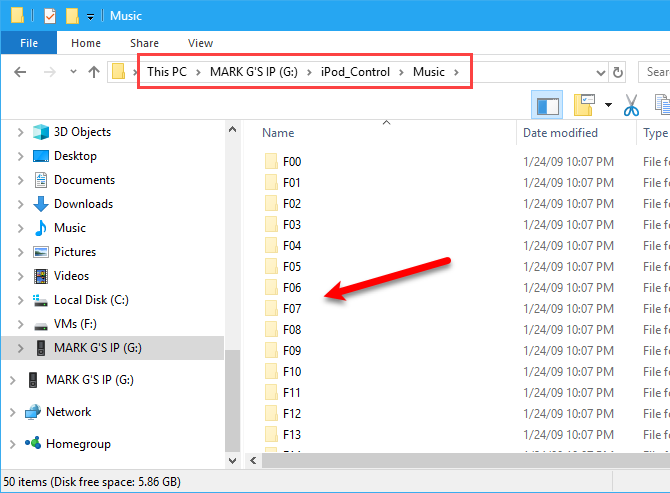
If your iPod bulldoze appears empty, you demand to reveal hidden files and folders on your computer.
Windows 7, 8, and 10 users tin can starting time utilize Alt + V to bring up the View tab. Afterward, printing the H key two times to reveal hidden items. You lot can and so either uncheck the Subconscious items box or repeat the procedure to hide your files.
For those using macOS, hold downward Cmd + Shift + Period to toggle subconscious folders on or off. Select all the folders in the iPod_Control > Music folder and copy and paste them to a location on your hard drive. This will transfer your music from your iPod to your computer. The files all take random 4-letter of the alphabet file names.
If you're using a Windows PC, you tin can see the tags for each music file in File Explorer. You won't come across the tags in Finder on a Mac. Later, we'll testify you how to easily change the file names using the tags.
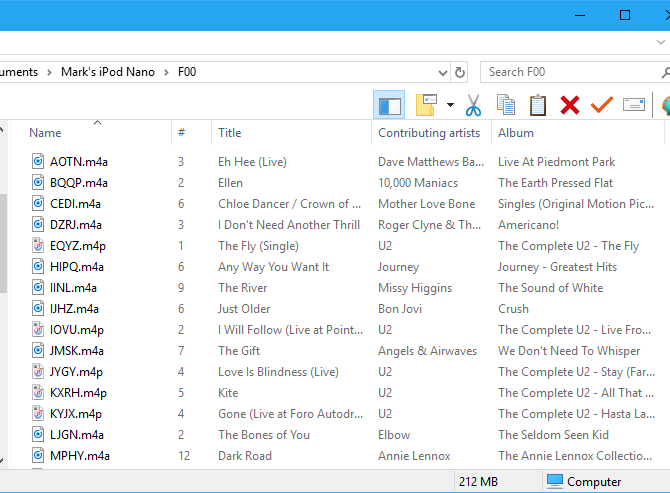
Once y'all've copied the files, you can eject the iPod and disconnect it. On a Windows PC, right-click on the iPod drive in File Explorer and select Squirt. Mac users should Command-click on the iPod icon on the desktop and select Eject.
If you lot don't want to use iTunes or Apple Music, you can also try these tools to manage your MP3 collection.
Step three. Add together the Music to Your iTunes Library
Later on transferring the music from your iPod to your computer, you tin first making adjustments. Beginning, add together the music from your iPod to your iTunes library on your Windows PC or Mac. Note that on macOS Catalina and newer, your music library appears in the Apple Music app since iTunes is gone.
By default, on Windows, adding items to your iTunes library creates a reference to the file's electric current location. The original file remains in the current location. Thus, if you were to move the original files, iTunes would no longer see them.
Yous can have iTunes for Windows make a copy of each file and place them into the iTunes media folder. Moving the original files would and then not touch on the music in your iTunes library.
How to Centralize Your iTunes Music on Your Computer
Open iTunes for Windows and become to Edit > Preferences. Click the Avant-garde tab and check the Re-create files to iTunes Media binder when calculation to library box. This option is checked past default in iTunes for Mac (on Mojave and earlier). Once enabled, all media added to your iTunes library from then on will copy straight to the iTunes media folder.
Now y'all won't have to worry well-nigh moving the original files anywhere else. Just call up, media added to your iTunes library before enabling that checkbox still links to the original media files.
How to Organize and Expand Your iTunes Library
To organize your iTunes Media binder into artist and anthology folders, check the Continue iTunes Media folder organized box. Again, iTunes or the Music app for Mac enables this option by default.
If you have infinite, it's a skillful idea to copy all your media files to the iTunes Media folder. That manner, they're all in one location and piece of cake to back up.
To re-create the remaining media files linked to in your iTunes library, go to File > Library > Organize Library. On the Organize Library dialog box, cheque the Consolidate files box and click OK.
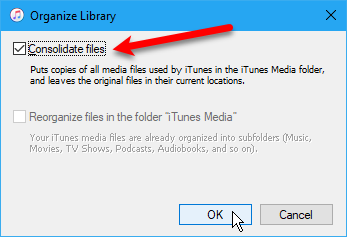
To add some or all of the music from your iPod to your iTunes library, get to either File > Add File to Library or File > Add Folder to Library in iTunes for Windows. If you're using a Mac, go to File > Add to Library. Then select the files or binder yous want to add. Yous can also add together music to iTunes by dragging music files from File Explorer or Finder to the iTunes window.
If you lot need to change or fix tags on your recently added music, you tin can do and then directly in iTunes or the Music app. You can alter or fix tags for either a single song or multiple songs every bit needed.
Editing a Single Tag
To edit tags on Windows, right-click on the vocal and select Song Info. If using a Mac, hold Command and click to select Album Info.
In the dialog box that displays, you'll run across several tabs containing information about the selected song. You can edit items like the song title, creative person, album, and genre. Click the buttons at the top to view and change the different data. To go to the adjacent song in the listing, click the arrows at the bottom of the dialog box. When done editing the tags, click OK.
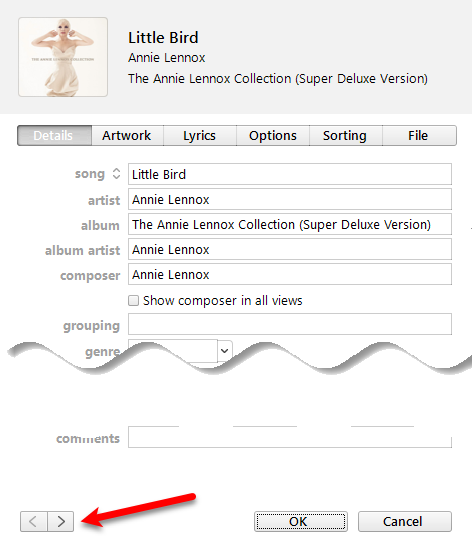
Editing Multiple Tags
You can besides edit common information for multiple songs at the aforementioned time. Use the Shift or Ctrl (Cmd on Mac) keys to select the songs yous want to edit. Then right-click on the selected songs and select Get Info.
A confirmation dialog box displays. If you don't desire to encounter this dialog box every time, check the Do not ask me again box.
Click Edit Items to go on. Only the tags that utilize to all the selected items brandish in the window. Click the buttons at the top to access the dissimilar types of information. Edit tags equally you want and click OK.
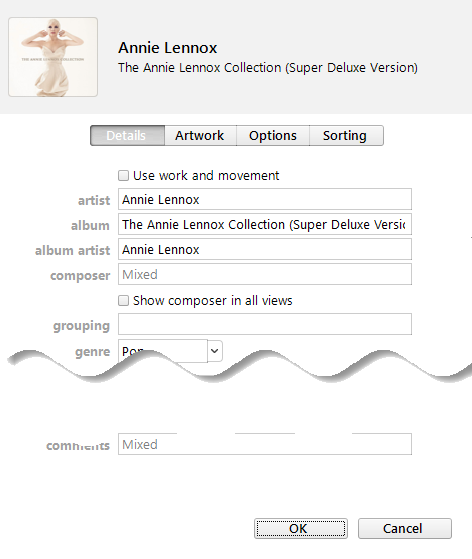
Step 5. Create a Playlist in iTunes
If you lot utilise playlists on your iPhone, you can create them in iTunes, and they'll sync to your iPhone. Whether using Mac or Windows, the process is the same. To create a playlist, select the songs yous want in the playlist. Then right-click on the selected songs and select Add to Playlist > New Playlist.
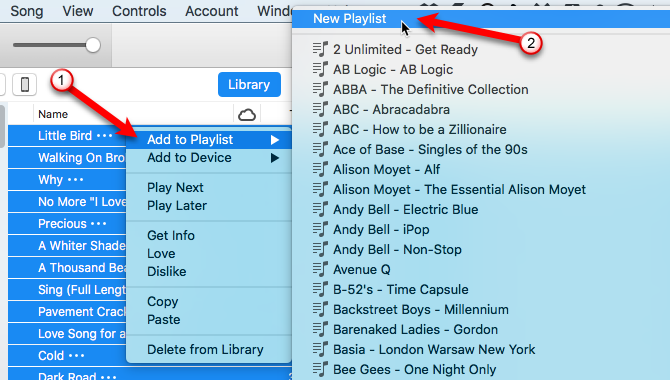
For similar songs (such as an album), the playlist is created using creative person and anthology title equally the name. If you create a playlist from various songs, y'all'll need to enter a custom name. To change the name of the playlist, click on the title and blazon a new championship. You tin can as well rearrange the songs in the playlist past dragging and dropping them to different positions.
Pace 6. Transfer Music to Your iPhone
To transfer the added music to your iPhone, make sure iTunes or Finder is open up and connect your device to your computer. So click the device icon at the peak of the iTunes window (or select the device in Finder on macOS Catalina and newer).
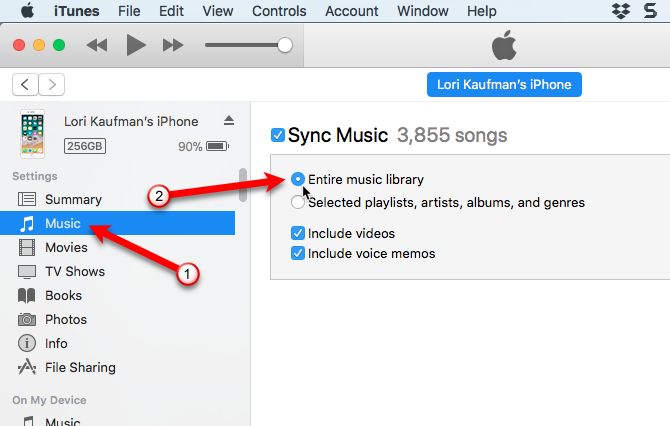
If you want to chop-chop sync content to your iPhone, y'all tin can use iTunes to sync your entire music library. Alternatively, if you only want to sync selected items, but the chosen playlists, artists, albums, and genres will sync.
In case you lot see a Replace and Sync message, recollect that the iTunes library replaces everything on your iPhone.
To sync your entire library, click Music in the sidebar on the left under Settings. So make sure to select Sync Music on the right and select Entire music library. At present press the Utilize button in the lower correct. If syncing doesn't begin, you can printing the Sync button.
Meanwhile, if you don't like iTunes, check out the all-time music director apps for iOS.
Pace seven. Rename the Music Files
In one case you've transferred your old iPod music, you tin rename the copied files. The random four-letter file names assigned to the files copied from your iPod aren't descriptive at all. On a Mac, you won't know what the songs are without adding them to iTunes or utilizing another app.
You lot can manually rename the files, but there's an easier way using a free tool chosen Mp3tag. It's a Windows program, but Mac users tin apply it via a workaround.
Rename Your Files With Mp3tag on Windows
On Windows, download Mp3tag and install it. To add Mp3tag to the File Explorer menu, check the Explorer Context Menu box on Choose Components screen during installation. To rename music files from your iPod, select the files in File Explorer. Then right-click on the files and select Mp3tag.
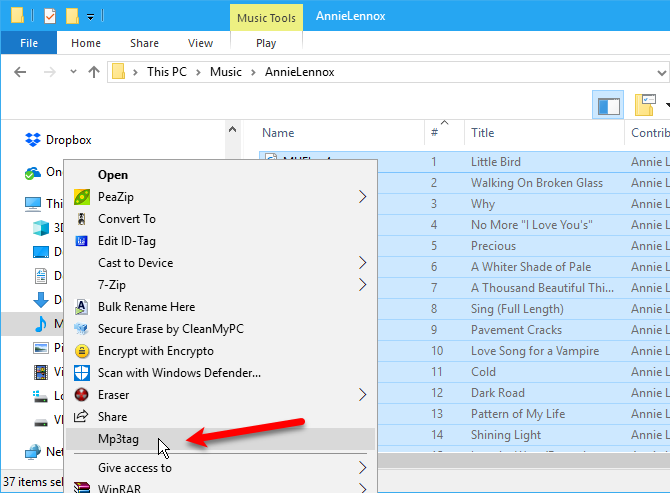
Inside the program, highlight your songs. Go to Convert > Tag - Filename or press Alt + 1. In the Tag - Filename dialog box, enter a Format string using placeholders to prepare up your filename scheme. For example, look at the Format cord in the image below. It creates a file proper noun with a two-digit track number, song title, artist name, and anthology name.
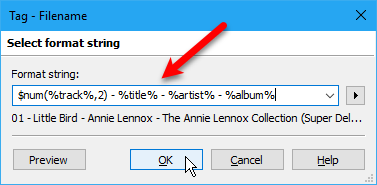
If you want to construct your own file name, you can use dissimilar format string placeholders available. Go to Assist > Contents to get more info nigh them. After the manual opens in your browser, click Renaming files based on tags under Working with tags and file names. You'll find a listing of placeholders you can use in the Format cord. Utilise these to create custom file names for your music files.
Alternatives and How to Apply Mp3tag on Mac
There are music tagging apps for Mac similar Kid3, but they aren't as piece of cake to employ as Mp3tag. If you have macOS 10.14.6 Mojave or later, the programmer of Mp3tag has a total version. However, Mac users either have to opt for a brusk-term trial or pay for the full app.
Yous tin can download Mp3tag for Mac from the developer website. If yous choose to purchase the full version, it'll cost you $19.99.
After it's finished downloading, add together it directly to the Applications folder on your Mac and run the prepackaged awarding. Apply the same steps listed higher up to rename music files using Mp3tag on your Mac.
If this all seems too much, try these alternatives to the Mac Music app and iTunes.
Animate New Life: Transfer Music from an Former iPod to Your Computer
If your old iPod yet charges enough to utilize, you tin can easily transfer music from that iPod to your computer. After transferring music from your iPod to iTunes or your iPhone, requite it a new purpose. Consider reusing your old iPod as an eBook reader or a secondary music collection holder.
About The Author
northcutttheavalogy.blogspot.com
Source: https://www.makeuseof.com/tag/transfer-music-ipod-computer/

0 Response to "Downloading Songs to Laptop and Then Uploading to Iphone"
Post a Comment